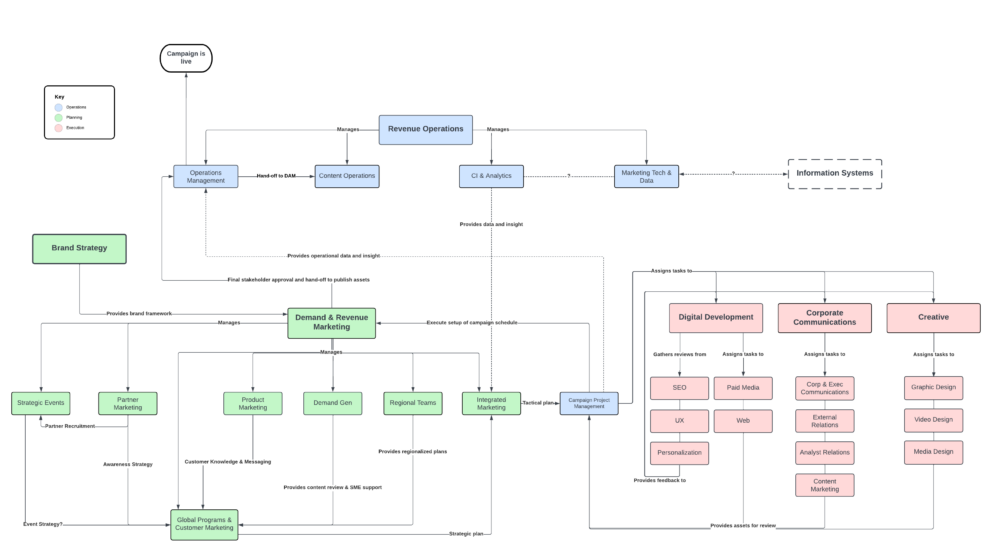Navigating Change Management for Process Efficiency and Alignment in B2B Sales and Marketing

Summary
In the ever-evolving world of B2B sales and marketing, success hinges on a dynamic trio: Change Management, Process Efficiency, and Alignment. Embracing change not only fuels innovation but also paves the way for streamlined processes and enhanced collaboration between sales and marketing teams. With actionable insights and next steps, this blog unravels the synergy between these three elements, proving how their integration empowers B2B professionals to navigate change, boost efficiency, and forge alignment for B2B excellence.
By Karla Sanders, Engagement Manager at Heinz Marketing
In today’s fast-paced business landscape, change is constant. B2B sales and marketing professionals are all too familiar with the need to adapt and evolve to stay ahead in a competitive market. Change management, process efficiency, and alignment are three critical elements that can make or break an organization’s success. In this blog, we will delve into the intricacies of these concepts and explore how they intersect for sustainable growth and innovation.
Change Management: Embracing the Inevitable
Change management involves the structured approach an organization takes to transition from its current state to a desired future state. It encompasses a range of processes, tools, and techniques that facilitate the adoption of change while minimizing resistance and disruptions. In B2B sales and marketing, change can stem from various factors such as technological advancements, market shifts, customer preferences, and competitive pressures.
One of the key challenges in change management is managing the human aspect. Employees often resist change due to fear of the unknown, disruption of routines, or even a lack of understanding about the rationale behind the change. It is crucial to communicate the need for change clearly and transparently, addressing concerns and highlighting the benefits it brings to the team and the organization.
Process Efficiency: Streamlining Operations for Optimal Performance
Process efficiency refers to the optimization of workflows, tasks, and activities to achieve maximum output with minimal resources and waste. Simply put, efficiency translates to better resource allocation, reduced operational costs, and quicker response times. However, achieving process efficiency requires a thorough understanding of existing processes, identifying bottlenecks, and leveraging technology to automate repetitive tasks.
Consider the lead generation process as an example. By employing data-driven strategies and automation tools, B2B sales and marketing professionals can streamline lead qualification, nurturing, and follow-up, ensuring that sales teams focus their efforts on high-potential leads. This not only boosts the overall conversion rate but also enhances customer experiences by delivering timely and relevant interactions.
Alignment: Bridging the Gap Between Sales and Marketing
Alignment between sales and marketing teams is a critical factor in B2B success. Historically, these two functions have operated in silos, leading to inefficiencies, miscommunication, and missed opportunities. However, in the modern landscape, where the buyer’s journey is interconnected and dynamic, alignment is no longer a luxury but a necessity.
Aligning sales and marketing involves breaking down barriers and fostering collaboration. Shared goals, metrics, and communication channels are essential to ensure both teams work in harmony to drive revenue and growth. Regular feedback loops and joint planning sessions allow sales and marketing professionals to gain insights from each other, refine strategies, and adapt quickly to market changes.
The Interplay: Change Management, Process Efficiency, and Alignment
The interplay between change management, process efficiency, and alignment can be likened to a three-legged stool. Each element supports and reinforces the others, creating a sturdy foundation for sustainable success in B2B sales and marketing.
Change Management as a Catalyst for Efficiency and Alignment
Implementing change can lead to process improvements that enhance efficiency. When introducing new technologies or methodologies, organizations can reevaluate and optimize existing workflows. Simultaneously, the process of change presents an ideal moment to foster alignment between sales and marketing. By involving representatives from both teams in the change planning process, organizations can align their objectives, reducing resistance and creating a sense of shared ownership.
Here are some steps you can tackle to enhance efficiency and foster alignment between sales and marketing teams. This approach not only optimizes processes but also creates a more collaborative and forward-focused work environment.
- Assessment and Planning: Start by assessing your current processes and identifying areas that need improvement. Plan how the proposed changes will address these inefficiencies.
- Clear Communication: Communicate the need for change to your teams. Explain the reasons, benefits, and potential outcomes. Address any concerns or misconceptions upfront.
- Cross-Functional Teams: Create a diverse team that includes members from both sales and marketing. Their different perspectives can offer valuable insights and enhance alignment.
- Process Mapping: Map out your existing processes to visualize the current workflow. Identify bottlenecks, redundant steps, and areas for improvement.
- Technological Integration: Introduce new technologies or methodologies that can streamline processes. Ensure these changes are aligned with the overall objectives of both sales and marketing teams.
- Pilot Implementation: Before full-scale deployment, test the proposed changes in a controlled environment. Gather feedback from your cross-functional team to make necessary adjustments.
- Training and Support: Provide comprehensive training to all team members affected by the change. Offer ongoing support to address any challenges or questions that arise during the transition.
- Metrics and Measurement: Define key performance indicators (KPIs) that reflect the desired efficiency and alignment outcomes. Regularly measure and track these metrics to gauge the success of the changes.
- Feedback Loop: Establish a feedback loop that encourages team members to share their experiences and suggestions for improvement. Use this input to refine the processes further.
- Celebrate Success: Once the changes have been fully implemented and positive results are evident, celebrate the achievements with your teams. Recognize their efforts and acknowledge.
Efficiency Driving Alignment
Process efficiency inherently demands collaboration and communication. When sales and marketing teams work together to streamline processes, they develop a deeper understanding of each other’s challenges and strengths. This shared understanding naturally fosters alignment as both teams recognize their interdependence for achieving common goals. Efficient processes also provide more time for joint activities, like brainstorming sessions or cross-functional training, further solidifying alignment.
Here are actionable steps for efficiency-driving alignments:
- Joint Process Review: Collaboratively examine existing processes within both sales and marketing teams. Identify areas where streamlining can enhance efficiency.
- Cross-Functional Workshops: Organize workshops where team members from both departments can contribute ideas to improve workflows. This encourages open dialogue and shared problem-solving.
- Shared Metrics: Define common metrics that measure the success of joint efforts. Having shared goals encourages both teams to work together towards achieving alignment.
- Resource Allocation: Optimize resource allocation by aligning both teams’ priorities. This ensures that resources are allocated where they can have the most impact.
- Regular Check-ins: Schedule regular cross-functional meetings to discuss ongoing projects, challenges, and opportunities. This practice promotes continuous communication and reduces the chances of misalignment.
- Collaborative Tools: Implement collaborative software or tools that allow sales and marketing teams to work together seamlessly. These tools can enhance communication and information sharing.
- Unified Customer Journey: Develop a unified understanding of the customer journey, where both sales and marketing teams contribute to shaping a consistent and effective experience.
- Feedback Loops: Establish feedback loops that enable both teams to provide input on each other’s activities. This creates a culture of mutual learning and improvement.
- Recognition and Rewards: Implement recognition and rewards programs that celebrate joint achievements. This reinforces the importance of alignment and collaboration.
- Skill Enhancement: Offer cross-functional training opportunities that help team members understand each other’s roles better. This mutual understanding enhances collaboration and alignment.
Alignment Enabling Change Management
A well-aligned sales and marketing organization is better equipped to navigate change. When these teams have a history of collaboration and open communication, introducing change becomes less daunting. Alignment creates a culture of adaptability, making it easier to introduce new tools, strategies, or workflows. Additionally, aligned teams are more likely to identify potential challenges and solutions, contributing to smoother change implementation.
By following these actionable steps, organizations can leverage alignment as a catalyst for effective change management.
- Shared Vision: Establish a clear and shared vision for both sales and marketing teams. When teams are aligned on the organization’s goals, introducing changes becomes a collective effort toward a common purpose.
- Cross-Functional Relationships: Encourage cross-functional relationships by organizing regular interactions between sales and marketing teams. This familiarity fosters trust and open communication, making change discussions more constructive.
- Change Champions: Identify change champions from both teams who can act as advocates for the proposed changes. These champions help convey the benefits and importance of the changes to their colleagues.
- Unified Communication: Develop a unified communication strategy that ensures that both sales and marketing teams are informed simultaneously about upcoming changes. This minimizes confusion and speculation.
- Inclusive Decision-Making: Involve representatives from both departments in the decision-making process for introducing changes. This inclusive approach reinforces alignment and shared ownership.
- Change Impact Analysis: Collaboratively analyze the potential impact of the proposed changes on both teams. This shared assessment helps identify potential challenges and allows for joint problem-solving.
- Adaptability Culture: Cultivate a culture that values adaptability and embraces change. When alignment is already ingrained in the team culture, the introduction of new tools or strategies is met with a positive mindset.
- Learning Opportunities: Offer joint learning opportunities where sales and marketing teams can learn about the changes together. This shared learning experience strengthens alignment and minimizes resistance.
- Collective Problem-Solving: Encourage joint problem-solving sessions where both teams discuss challenges that arise during the change process. This collaborative approach facilitates quicker solutions.
- Feedback Integration: Incorporate feedback from both sales and marketing teams into the change implementation process. This input helps refine the changes and ensures they align with both teams’ needs.
Conclusion
Change is a constant force, by embracing change management, striving for process efficiency, and fostering alignment between sales and marketing teams, organizations can navigate the challenges of today’s business landscape while capitalizing on growth opportunities. Recognizing the interconnected nature of these three elements and investing in their integration will undoubtedly position businesses for long-term success. As B2B professionals, your journey toward change, efficiency, and alignment starts with a commitment to embracing a culture of continuous improvement and collaboration.




